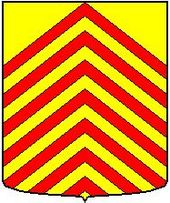Egmond (noble family)
The House of Egmond (also written as Egmont ) was a Dutch nobility family .
timeline
It was named after the Egmond monastery , which the family administered as rebels . According to a legend, Radbold van Egmond (called 876-932), the bailiff of the monastery, is the tribe of Heeren van Egmond . In the course of the 14th century the Egmond dynasty was able to expand its holdings and was thus drawn into the battles against the West Frisians and into feuds . Subsequently, in the Dutch hook-and-cod war , the gentlemen von Egmond and the gentlemen van Arkel took the lead in cod . At the end of the 14th century, Arnold von Egmond inherited the barony of IJsselstein with a castle on the border of Utrecht and Holland. From this point on, the sex was also involved in the Utrecht feuds.
During the late Middle Ages and the Renaissance , the lords and later Counts of Egmond , who were endowed with numerous privileges ( Johann III of Egmond was made the first Count of Egmond in 1486), developed into one of the leading Dutch aristocratic families. In addition to the main branches of the family that governed duchies and counties, there were also various extramarital branches: Egmond van Merenstein (extinct in 1559), Egmond van Kenenburg (extinct in 1703), Egmond van Cranenburch. The van Egmond van de Nijenburg family , however, only wrongly presented itself as an extramarital branch of the Egmonds.
The progenitor of the noble family "Geldern-Egmond" or "Geldern-Egmont" is Reiner von Geldern (1460–1522), natural son of Adolf von Egmond , Duke v. Geldern (1438-1477). The family owned Arcen 1503–1779, belonged to the knights of Geldern and Jülich, and had been a baron since the 17th century. - Imperial Count Munich July 15, 1790.
family members
- Jan II of Egmond (1385–1451), regent of the Duchy of Geldern
- Arnold von Egmond (1410–1473), Duke of Geldern
- Wilhelm von Egmond (1412–1483) Count von Egmond, Lord of IJsselstein , governor of Geldern
- Johann III. von Egmond (1438–1516), governor of Holland , Zeeland and Friesland
- Adolf von Egmond (1438–1477), Duke of Geldern
- Karl von Egmond (1467–1538), Duke of Geldern
- Philippa von Egmond (1464–1547), married to Duke René II of Lorraine
- Floris von Egmond (1469–1539), Count von Buren , governor of Geldern and Friesland
- Georg von Egmond , Prince- Bishop of Utrecht
- Maximilian von Egmond (1509–1548), Count von Buren, governor of Friesland, Groningen and Overijssel , captain-general of the Netherlands
- Anna von Egmond (1533–1558), Countess von Buren, Leerdam and Lingen (Ems) , wife of Wilhelm the Silent
- Lamoral von Egmond (1522–1568), 4th Count of Egmond, Prince of Gavere , governor of Flanders and Artois ; served as the main character in Goethe's tragedy Egmont
- Philip von Egmond (1558–1590), 5th Count of Egmond, Prince of Gavere
Title of the House of Egmond (selection)
- Lords and Counts of Egmond (early 10th century - 1682)
- Barons of IJsselstein (1369–1558)
- Dukes of Geldern (1423–1473, 1477)
- Counts of Zutphen (1423–1473)
- Barons of Eindhoven (1483–1581)
- Counts of Lingen (1547–1551)
- Counts of Buren and Leerdam (1472 / 92–1558)
- Lords of Purmerend and Purmerland (1483–1568 / 1582)
- Princes of Gavere (1553–1682)
literature
- Pieter Lodewijk Muller: Egmond . In: Allgemeine Deutsche Biographie (ADB). Volume 5, Duncker & Humblot, Leipzig 1877, p. 683 f.
- Ralf G. Jahn: The Counts of Geldern-Egmond (t) . In: Ralf G. Jahn, Karl-Heinz Tekath, Bernhard Keuck (eds.): A good neighbor is a noble gem. The Duchy of Geldern in the field of tension between alliance and competition on the Meuse, Rhine and IJssel . Geldern 2005. ISBN 3-921760-33-X . Pp. 153-161.


